Assessing the Ecological Effects of Water Transport to a Lake in Arid Regions: A Case Study of Qingtu Lake in Shiyang River Basin, Northwest China
Abstract
1. Introduction
2. Study Area
3. Data and Methodologies
3.1. Field Investigation
3.2. Remote Sensing Interpretation
3.2.1. Remote Sensing Images Selection and Pre-Processing
3.2.2. Normalized Difference Vegetation Index and Supervised Classification
4. Results and Discussion
4.1. Water Surface Area and Spatial Distribution of Groundwater Depth after Water Transport
4.1.1. The Water Surface Area of Qingtu Lake in 2018
4.1.2. Spatial Distribution of Groundwater Depth in 2018
4.2. Changes in Vegetation around Qingtu Lake
4.2.1. Spatiotemporal Changes in Vegetation Coverage
4.2.2. Spatiotemporal Changes in P. australis and N. tangutorum Communities around Qingtu Lake
5. Conclusions
- Initially, when the water transport was set up in September 2010, Qingtu Lake gradually reformed a large continuous surface, with an area of 5.68 km2 by July 2018. The water transport replenished the local groundwater and the lake formed a spatial gradient distribution in groundwater depth. The depth increased in gradient from the waterside to the desert edge.
- The overall vegetation coverage around Qingtu Lake increased significantly since water transport began, especially from 2014 to 2015, while it decreased slightly in 2018, with the NDVI reaching 0.14. In addition, after water delivery, the vegetation in the study area was more distributed in shallow waters and its surrounding areas.
- There was a slight increase in N. tangutorum communities in 2018 compared with numbers in 2010. However, the area where P. australis communities are found increased by approximately 10 km2. In addition, from the waterside to the desert edge, the vegetation showed a gradient distribution in which the species transitioned from hygrophytes to xerophytes. It can be concluded that the water transport was beneficial to the restoration of the regional vegetation and the ecological environment, with good ecological effects.
Author Contributions
Funding
Conflicts of Interest
References
- Chen, Y.; Li, W.; Xu, H.; Liu, J.; Zhang, H.; Chen, Y. The influence of groundwater on vegetation in the lower reaches of Tarim River, China. Acta Geogr. Sin. 2003, 58, 549–557. [Google Scholar]
- Cheng, G.; Xiao, D.; Wang, G. On the characteristics and building of landscape ecology in arid area. Adv. Earth Sci. 1999, 14, 11–15. [Google Scholar]
- Chen, Y.; Chen, Y.; Xu, C.; Ye, Z.; Li, Z.; Zhu, C.; Ma, X. Effects of ecological water conveyance on groundwater dynamics and riparian vegetation in the lower reaches of Tarim River, China. Hydrol. Process. 2010, 24, 170–177. [Google Scholar] [CrossRef]
- Huo, Z.; Feng, S.; Kang, S.; Li, W.; Chen, S. Effect of climate changes and water-related human activities on annual stream flows of the Shiyang river basin in arid north-west China. Hydrol. Process. 2008, 22, 3155–3167. [Google Scholar] [CrossRef]
- Karthe, D. Environmental changes in Central and East Asian drylands and their effects on major river-lake systems. Quat. Int. 2018, 475, 91–100. [Google Scholar] [CrossRef]
- Xu, H.; Chen, Y.; Li, W. Study on response of groundwater after ecological water transport at the lower reaches of the Tarim River. Res. Environ. Sci. 2003, 16, 19–38. [Google Scholar]
- Liu, S.; Yuan, H.; Liu, S.; Liu, H.; Li, F.; Guo, S.; Wang, Q.; Li, J.; Wei, H. Characteristics of soil particle fractal dimension after formation of water area in tail-streams of Shiyang River. Bull. Soil Water Conserv. 2013, 6, 285–289. [Google Scholar]
- Micklin, P. The future Aral Sea: Hope and despair. Environ. Earth Sci. 2016, 75, 844. [Google Scholar] [CrossRef]
- Zhang, T.; Yuan, Y.; Liu, Y.; Wei, W.; Zhang, R.; Chen, F.; Yu, S.; Shang, H.; Li, Q. A tree-ring based temperature reconstruction for the Kaiduhe River watershed, northwestern China, since A.D. 1680: Linkages to the North Atlantic Oscillation. Quat. Int. 2013, 311, 71–80. [Google Scholar] [CrossRef]
- Chen, Y.; Zhang, X.; Zhu, X.; Li, W.; Zhang, Y.; Xu, H.; Zhang, H.; Chen, Y. Analysis on the ecological benefits of the stream water conveyance to the dried-up river of the lower reaches of Tarim River, China. Sci. China Ser. D 2004, 47, 1053–1064. [Google Scholar] [CrossRef]
- Chen, Y.; Li, W.; Xu, C.; Ye, Z.; Chen, Y. Desert riparian vegetation and groundwater in the lower reaches of the Tarim River basin. Environ. Earth Sci. 2015, 73, 547–558. [Google Scholar] [CrossRef]
- Zhang, P.; Guli, J.; Bao, A.; Meng, F.; Guo, H.; Guo, H.; Luo, M.; Huang, X. Ecological effects evaluation for short term planning of the tarim river. Arid Land Geogr. 2017, 40, 156–164. [Google Scholar]
- Li, B.; Zhang, Y.; Yu, J.; Du, C. Research on wetland restoration process of the East Juyan Lake. Geogr. Res. 2017, 36, 1223–1232. [Google Scholar]
- Dong, Z.; Xu, X.; Jin, H.; Liu, S.; Zhang, J.; Tang, W.; Chai, C.; Zhao, P.; Wang, X. The impact of eco-water transportation to the vegetation in tail lake of Shiyang River. J. Arid Land Resour. Environ. 2015, 7, 101–106. [Google Scholar]
- Zeng, Y.; Xie, Z.; Yu, Y.; Liu, S.; Wang, L.; Jia, B.; Qin, P.; Chen, Y. Ecohydrological effects of stream–aquifer water interaction: A case study of the Heihe River basin, northwestern China. Hydrol. Earth Syst. Sci. 2016, 20, 2333–2352. [Google Scholar] [CrossRef]
- Zhang, X.; Tao, H. Evolution and conservation policy of wetland in Qingtuhu of the Minqin County. Gansu Sci. Technol. 2011, 27, 7–9. [Google Scholar]
- Kang, S.; Su, X.; Tong, L.; Shi, P.; Yang, X.; Abe, Y.; Du, T.; Shen, Q.; Zhang, J. The impacts of human activities on the water–land environment of the Shiyang River basin, an arid region in northwest China/Les impacts des activités humaines sur l’environnement pédo-hydrologique du bassin de la Rivière Shiyang, une région aride du nord-ouest de la Chine. Hydrol. Sci. J. 2004, 49, 413–427. [Google Scholar]
- Chen, Z.; Liu, S.; Liu, S.; Sun, T. Response of Form. Phragmites australis and Form. Nitraria tangutorum after ecological water delivery to Qingtu Lake. Pratacult. Sci. 2015, 12, 1960–1968. [Google Scholar]
- Ståhl, G.; Ekström, M.; Dahlgren, J.; Esseen, P.A.; Grafström, A.; Jonsson, B.G. Informative plot sizes in presence-absence sampling of forest floor vegetation. Methods Ecol. Evol. 2017, 8, 1284–1291. [Google Scholar] [CrossRef]
- Oliver, M.A.; Webster, R. Kriging: A method of interpolation for geographical information systems. Int. J. Geogr. Inf. Syst. 1990, 4, 313–332. [Google Scholar] [CrossRef]
- Gao, B. NDWI—A normalized difference water index for remote sensing of vegetation liquid water from space. Remote Sens. Environ. 1996, 58, 257–266. [Google Scholar] [CrossRef]
- Li, C.; Li, W. Tendency analysis and spatial pattern of aboveground vegetation biomass based on NDVI in sunite left banner, Xilingole. J. Arid Land Res. Environ. 2010, 24, 147–152. [Google Scholar]
- Guo, N. Vegetation index and its advances. J. Arid Meteorol. 2003, 21, 71–75. [Google Scholar]
- Wang, F.; An, P.; Cai, L.; Huang, X.; Hao, J. Monitoring effects of ecosystem restructuring project for returning grain plots to forestry in Wuchuan county of Inner Mongolia based on RS and GIS. Trans. Chin. Soc. Agric. Eng. 2015, 31, 269–277. [Google Scholar]
- Li, S.; Wang, J.; Bi, Y.; Chen, Y.; Zhu, M.; Yang, S.; Zhu, J. A review of methods for classification of remote sensing images. Remot. Sens. Land Resour. 2005, 64, 1–6. [Google Scholar]
- Pal, M.; Mather, P.M. An assessment of the effectiveness of decision tree methods for land cover classification. Remote Sens. Environ. 2003, 86, 554–565. [Google Scholar] [CrossRef]
- Ma, S.; Li, J. The use of different sand barriers and effects to surrounding government. J. Anhui Agric. Sci. 2011, 17, 10415–10416. [Google Scholar]
- Li, J. Holocene Vegetation and Environmental Change at Qingtu Lake in the Shiyang River Drainage. Ph.D. Thesis, Lanzhou University, Lanzhou, China, 2006. [Google Scholar]
- Wang, W.; Jiang, W.; Xie, Z.; Zhang, D.; Gong, X.; Kou, J. Study on soil water in rhizosphere and root system distribution of Nitraria tangutorum on Loess Plateau. Acta Pratacult. Sin. 2013, 22, 20–28. [Google Scholar]
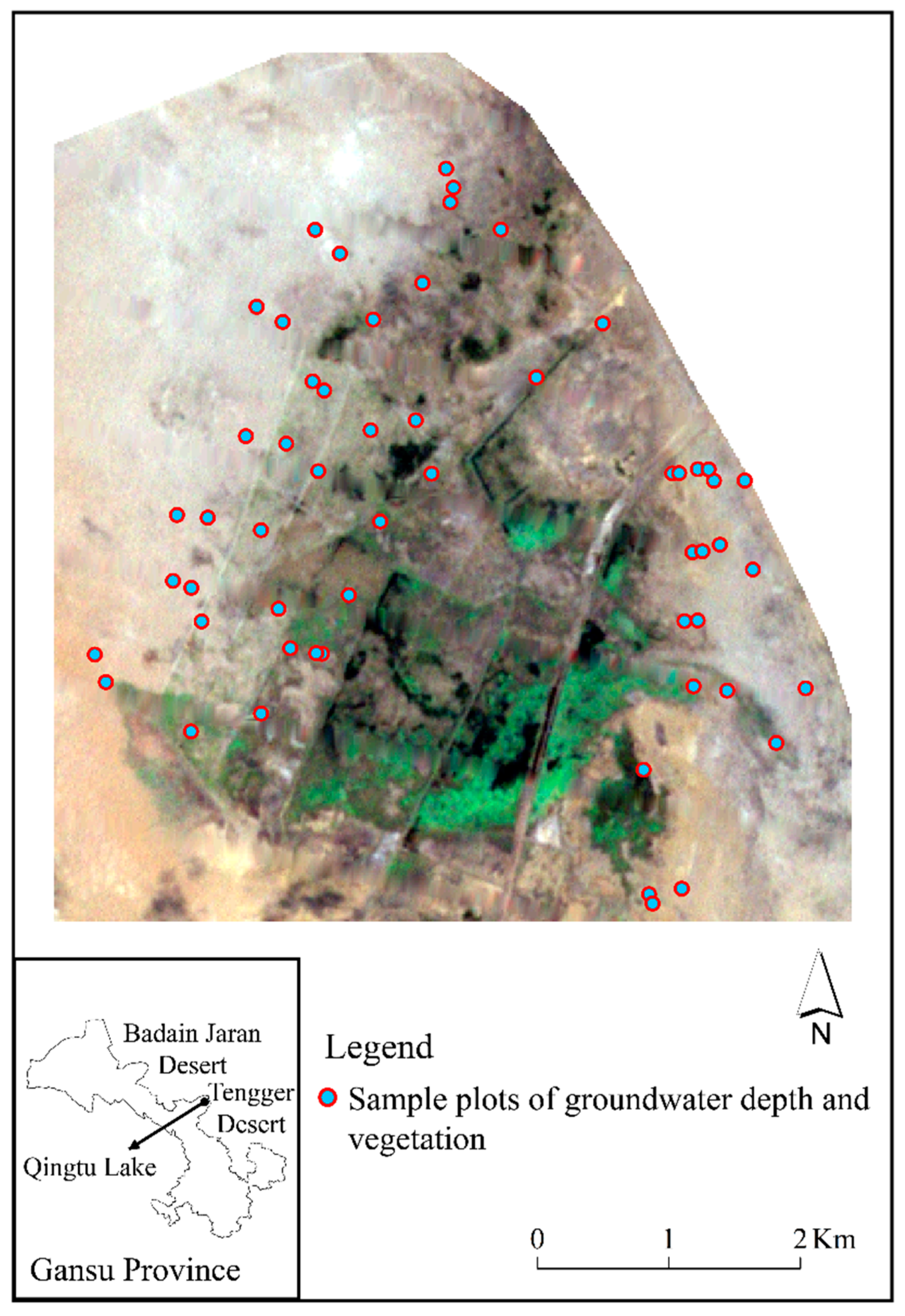
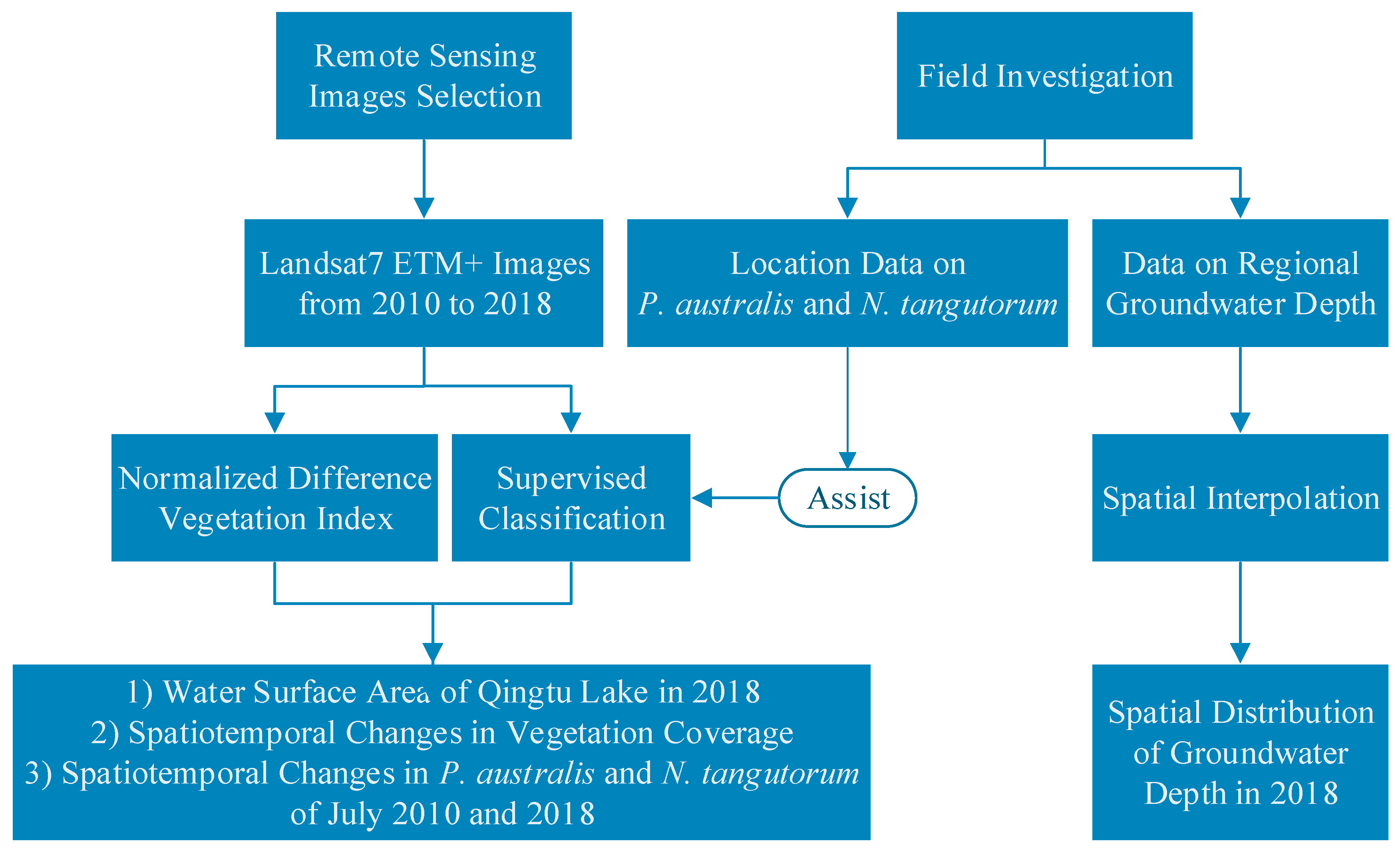
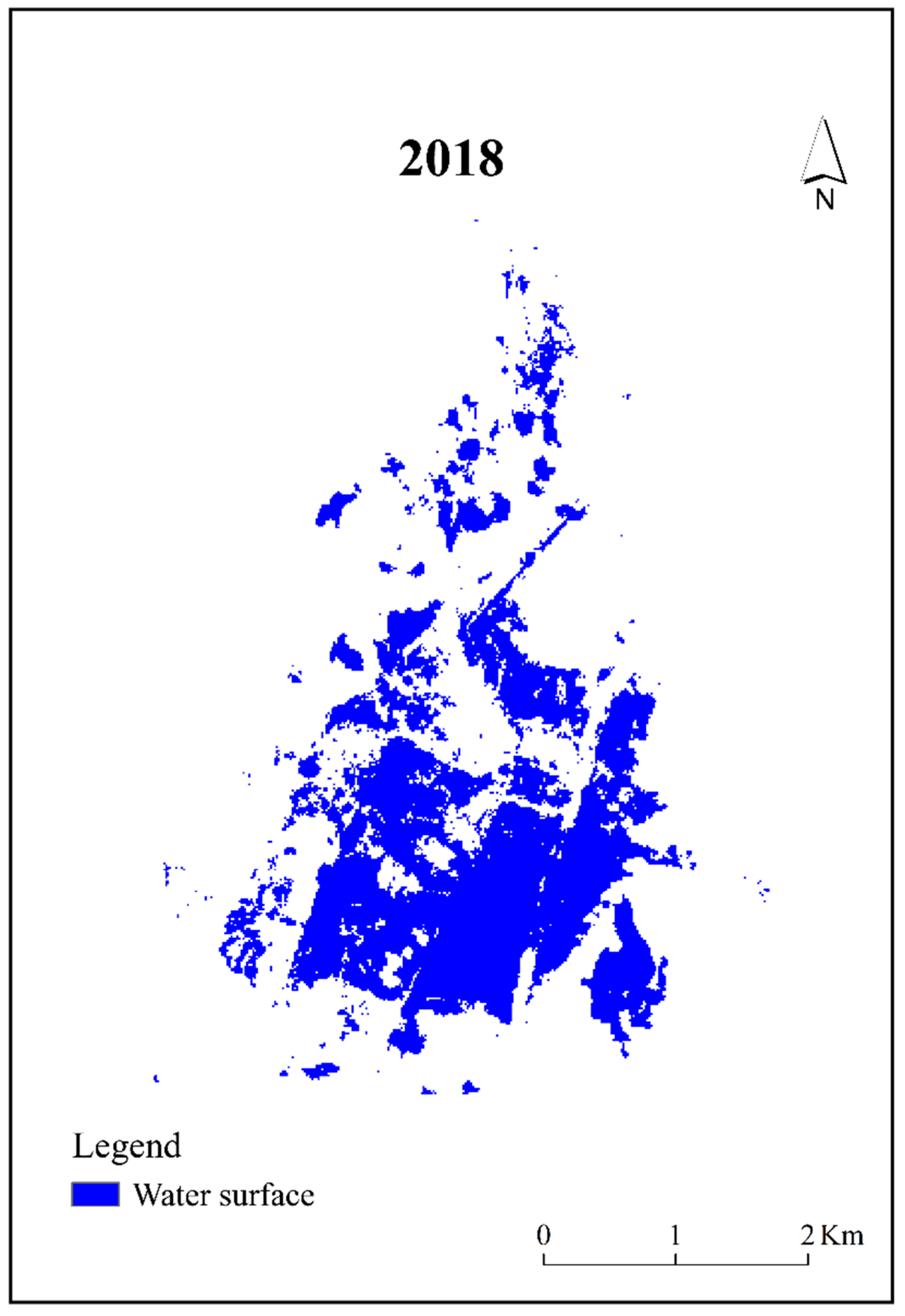
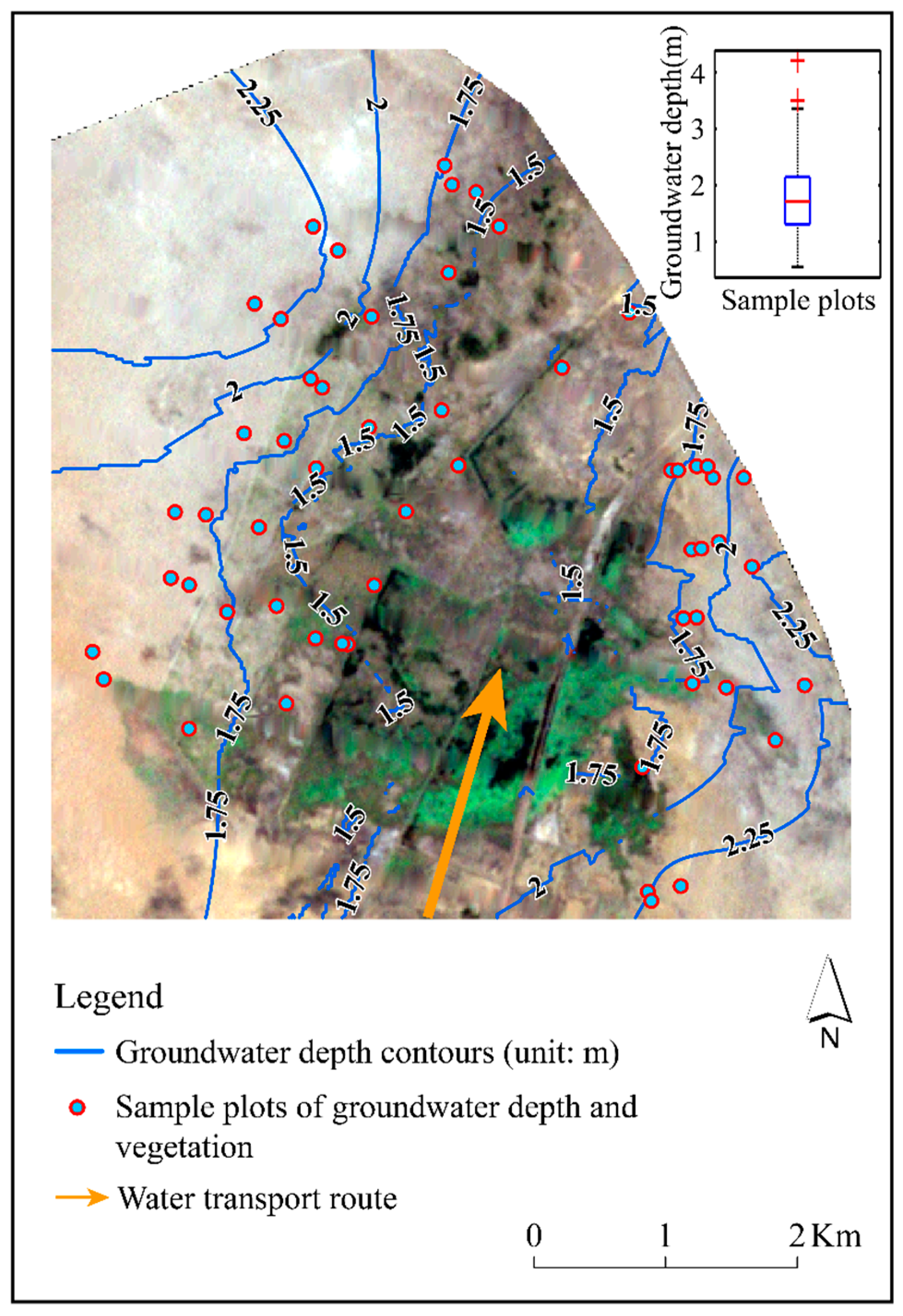
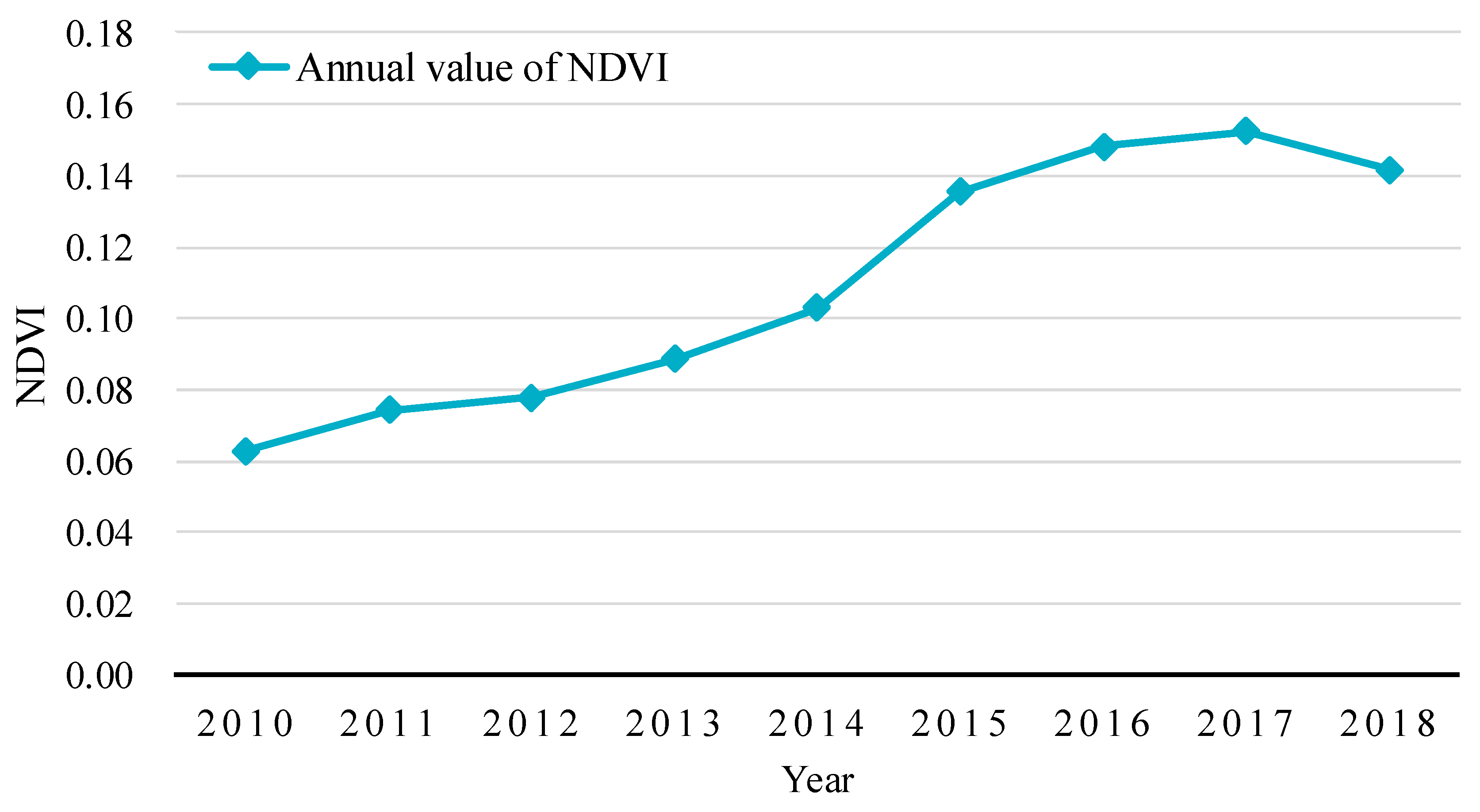
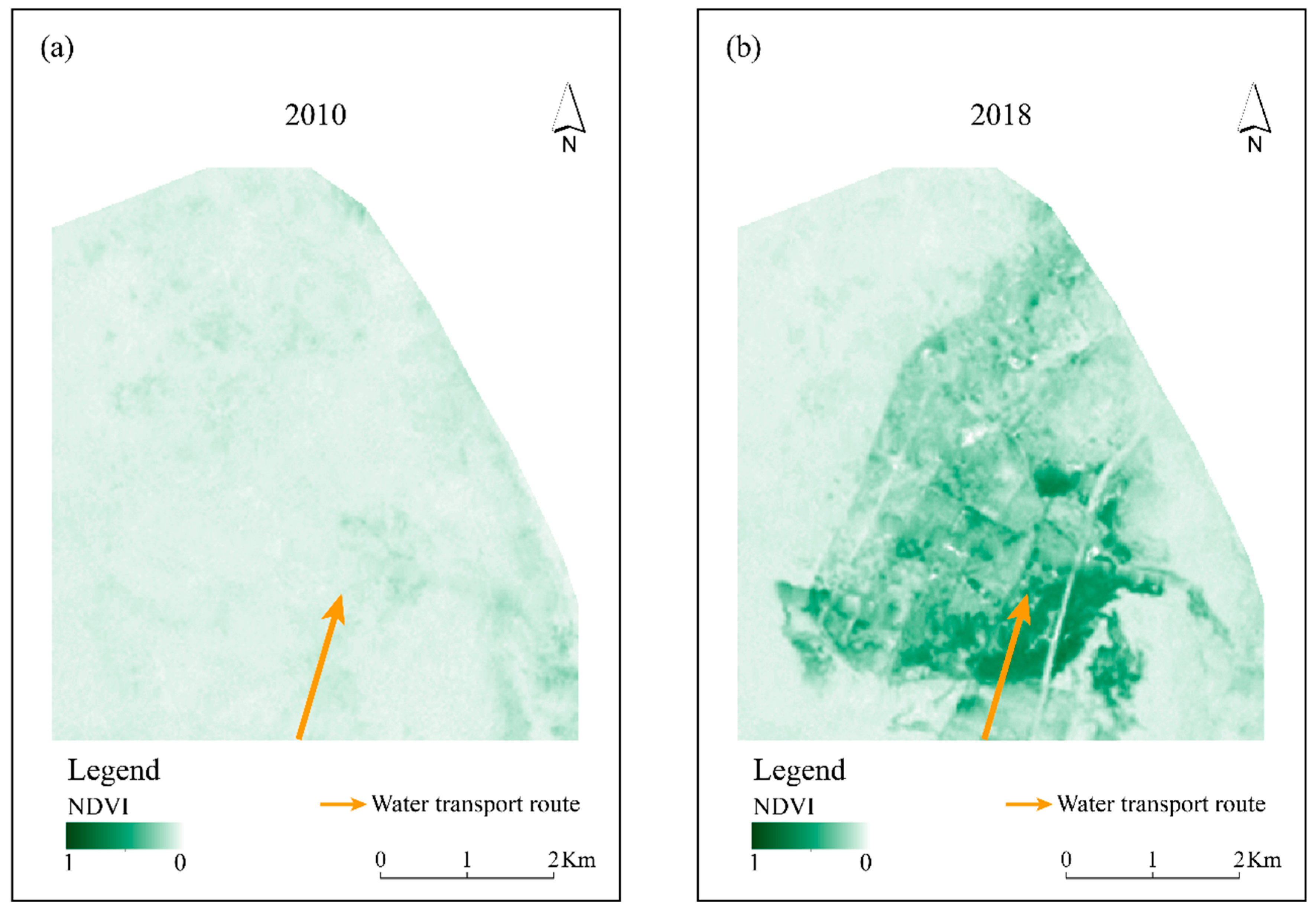
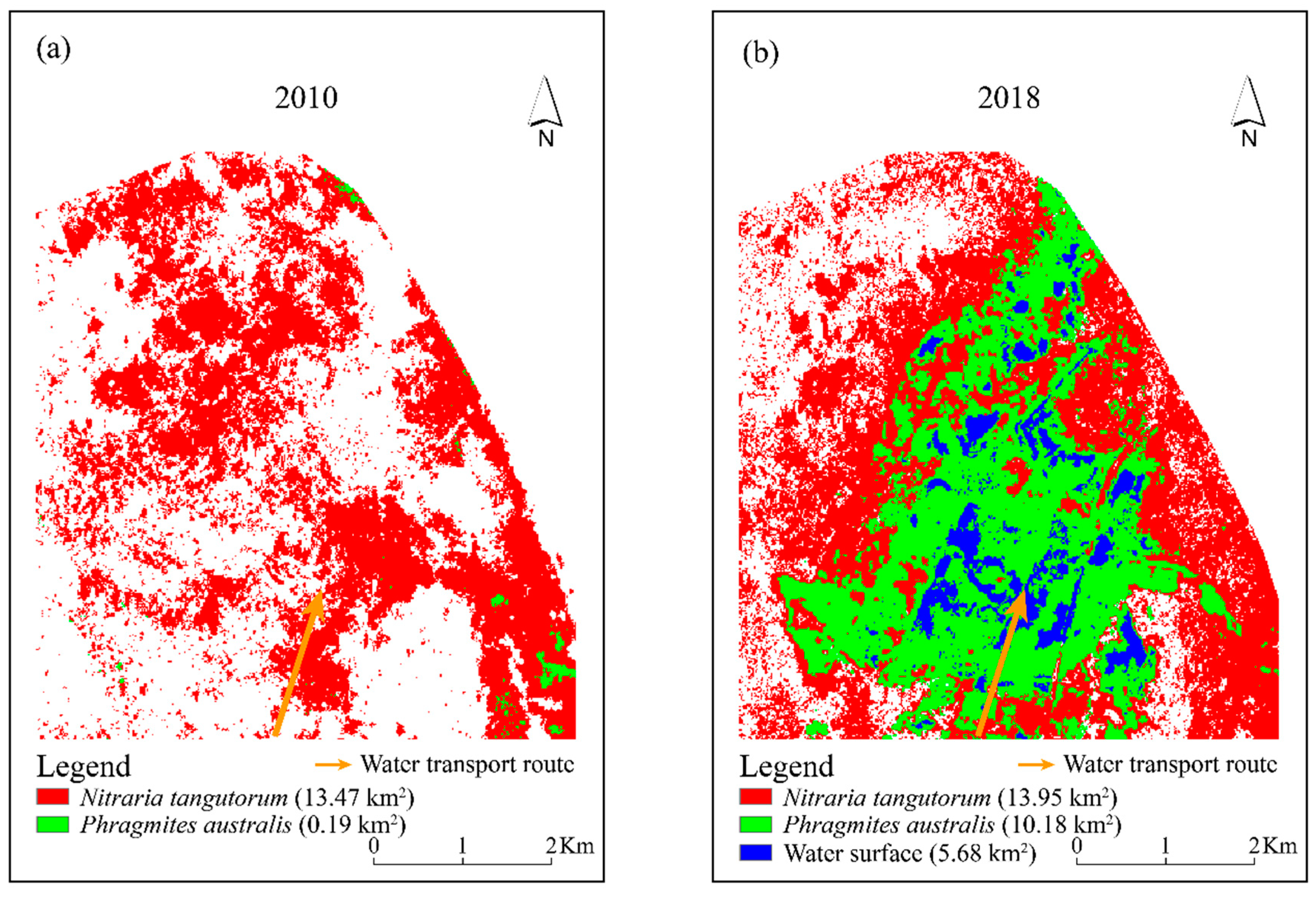
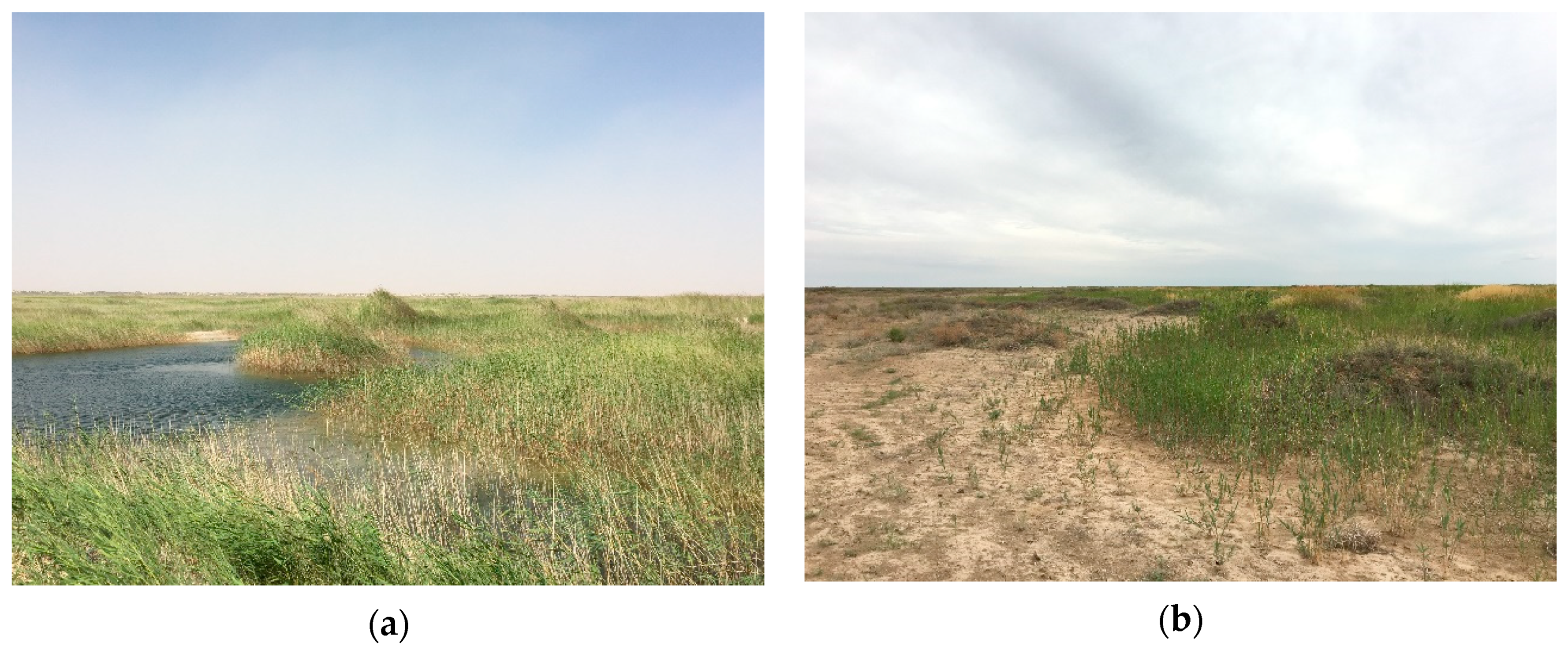
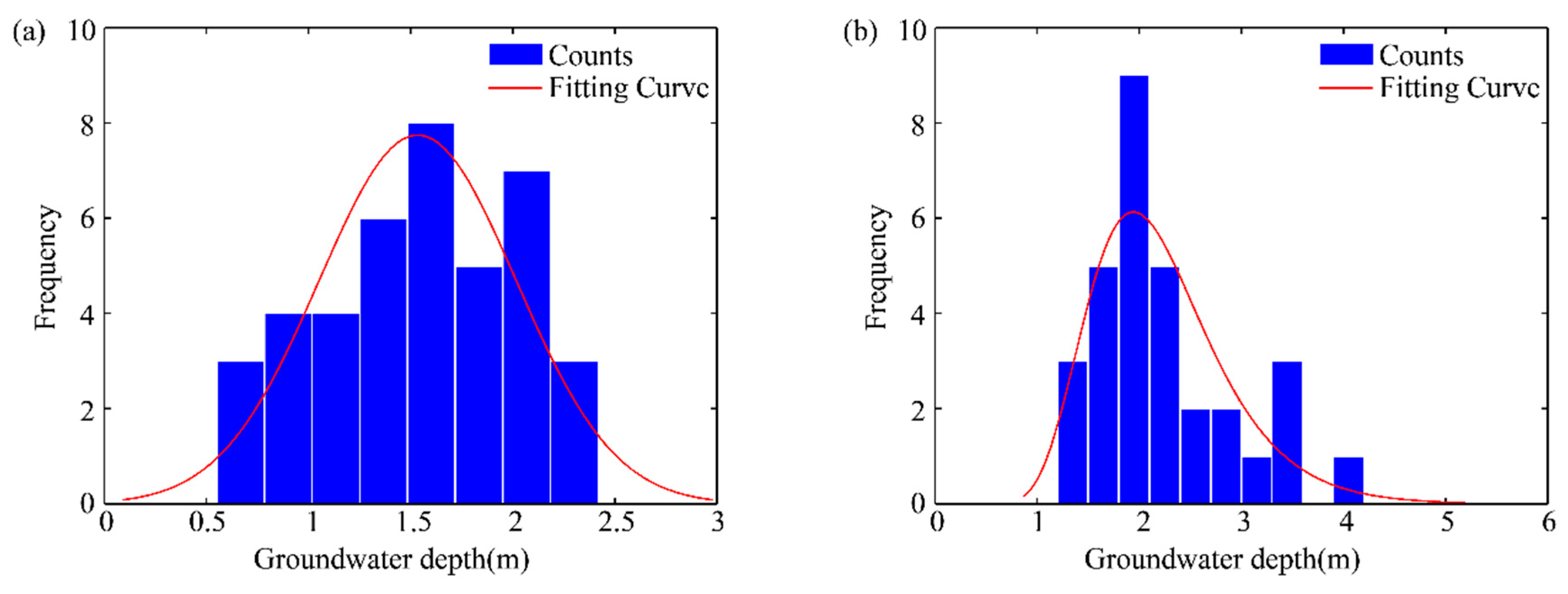
| Typical Vegetation | μ/m | σ/m | Fitting Curves Equations |
|---|---|---|---|
| P. australis | 1.53 | 0.48 | |
| N. tangutorum | 0.75 | 0.30 |
© 2019 by the authors. Licensee MDPI, Basel, Switzerland. This article is an open access article distributed under the terms and conditions of the Creative Commons Attribution (CC BY) license (http://creativecommons.org/licenses/by/4.0/).
Share and Cite
Chunyu, X.; Huang, F.; Xia, Z.; Zhang, D.; Chen, X.; Xie, Y. Assessing the Ecological Effects of Water Transport to a Lake in Arid Regions: A Case Study of Qingtu Lake in Shiyang River Basin, Northwest China. Int. J. Environ. Res. Public Health 2019, 16, 145. https://doi.org/10.3390/ijerph16010145
Chunyu X, Huang F, Xia Z, Zhang D, Chen X, Xie Y. Assessing the Ecological Effects of Water Transport to a Lake in Arid Regions: A Case Study of Qingtu Lake in Shiyang River Basin, Northwest China. International Journal of Environmental Research and Public Health. 2019; 16(1):145. https://doi.org/10.3390/ijerph16010145
Chicago/Turabian StyleChunyu, Xunzhou, Feng Huang, Ziqiang Xia, Danrong Zhang, Xi Chen, and Yongyu Xie. 2019. "Assessing the Ecological Effects of Water Transport to a Lake in Arid Regions: A Case Study of Qingtu Lake in Shiyang River Basin, Northwest China" International Journal of Environmental Research and Public Health 16, no. 1: 145. https://doi.org/10.3390/ijerph16010145
APA StyleChunyu, X., Huang, F., Xia, Z., Zhang, D., Chen, X., & Xie, Y. (2019). Assessing the Ecological Effects of Water Transport to a Lake in Arid Regions: A Case Study of Qingtu Lake in Shiyang River Basin, Northwest China. International Journal of Environmental Research and Public Health, 16(1), 145. https://doi.org/10.3390/ijerph16010145






